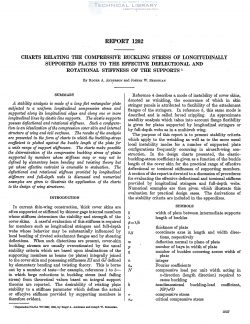naca-report-1202
- Version
- 218 Downloads
- 1.99 MB File Size
- 1 File Count
- November 2, 2016 Create Date
- November 2, 2016 Last Updated
National Advisory Committee for Aeronautics, Report - Charts Relating the Compressive Buckling Stress of Longitudinally Supported Plates to the Effective Deflectional and Rotational Stiffness of the Supports

A stability analysis is made of a long jlat rectangular plate
subjected to a uniform longitudinal compressive stress and
supported along its longitudinal edges and along one or more
longitudinal lines by elastic line supports. The elastic supports
possess dejlectional and rotational stiflness. Such a configura-
tion is an idealization of the compression cover skin and internal
structure of wing and tail surfaces. The results of the analysis
are presented in the form of charts in which the buckling-stress
coefl‘icient is plotted against the buckle length of the plate for
a wide range of support stifi'nesses. The charts make possible
the determination of the compressive buckling stress of plates
supported by members whose stiffness may or may not be
defined by elementary beam bending and twisting theory but
yet whose efiectioe restraint is amenable to evaluation. The
deflectional and rotational stifiness provided by longitudinal
stifleners and full-depth webs is discussed and numerical
emmples are given to illustrate the application of the charts
to the design of wing structures.
In current thin-wing construction, 'thick cover skins are
often supported or stiffened by thinner gage internal members
whose stillness determines the stability and strength of the
cover skins. A. careful evaluation of this stiflness is required
for members such as longitudinal stringers and full-depth
webs whose behavior may be substantially influenced by
local bending of riveted attachment flanges and by shearing
deflections. When such distortions are present, cover-sldn
buckling stresses are usually overestimated by the usual
stability criteria which are based upon idealizations of the
supporting members as beams (or plates) integrally joined
to the cover skin and possessing stiffnesses EI and GJ defined
by elementary bending and twisting theory. This is borne
out by a number of tests—for example, references 1 to 3—
in which large reductions in buckling stress (and failing
stress) from theoretical values based on integral support
theories are reported. The desirability of relating plate
stability to a stiffness parameter which defines the actual
or effective stiffness provided by supporting members is
therefore evident.
| File | Action |
|---|---|
| naca-report-1202 Charts Relating the Compressive Buckling Stress of Longitudinally Supported Plates to the Effective Deflectional and Rotational Stiffness of the Supports.pdf | Download |
Comment On This Post